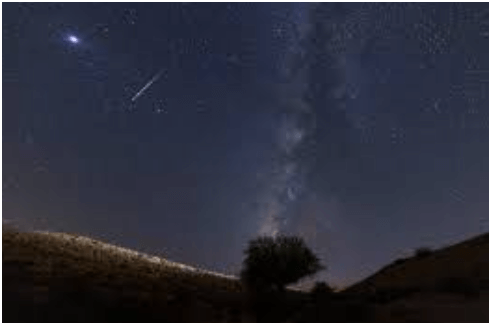Da Vinci glow and the Perseid meteor shower offer a chance to experience the magic of the night sky and create lasting memories.
In the coming days, celestial observers gazing at the UAE sky may catch a glimpse of the Da Vinci glow. This phenomenon occurs around sunset when a crescent moon is on the horizon, yet the outline of a full moon is still visible. Sarath Raj, Project Director of the Amity University Dubai Satellite Ground Station and Programme Leader of Aerospace Engineering at Amity University Dubai, explained, “The so-called ‘Da Vinci glow’ is a captivating celestial phenomenon where a faint, ethereal light illuminates the unlit portion of the Moon.
Da Vinci glow is mostly visible when the moon is a thin crescent and appears typically a few days after the new Moon. The next new moon in the UAE is on August 4.”
He continued, “This ghostly glow, often referred to as ‘earthshine,’ is caused by sunlight reflecting off Earth’s surface and back onto the Moon. When looking at a crescent moon, sometimes, you can see a faint glow on the part of the moon that’s usually dark. This is called the ‘Da Vinci Glow.’ It’s like Earth is acting as a giant mirror.” Notably, August is also a prime time for stargazing due to a combination of weather and astronomical factors.
With longer nights and the Earth in a favorable position, sky gazers have a better chance of spotting stars, planets, and even meteor showers like the Perseids. Hasan Al Hariri, Chief Executive Officer (CEO) of Dubai Astronomy Group, put the celestial spectacle in perspective. “The natural phenomenon occurs because the direction and radiant point, from which the shower seems to come in the sky, lie in the same direction as the Perseus constellation,” he said.
Da Vinci glow Meteors are small fragments of rock and dust left behind by comets and asteroids in their debris trails as they orbit the Sun. Each year, as the Earth passes through these debris trails at roughly the same time, annual meteor showers are experienced. Some of the most famous showers, such as the Perseids, can dazzle viewers with dozens of meteors per hour at their peak.
“The Perseids arise when the Earth passes through the debris of Comet 109P/Swift-Tuttle, which was first discovered in 1862. The comet’s last brush with the inner solar system occurred in 1992, leaving a dusty trail of debris that our planet passes through each summer,” he added. “When this debris hits the Earth’s atmosphere, it burns and creates visible streaks in the sky. So, the Perseids are rich in fireballs and the show should be really nice.”
Occurring annually between mid-July and late August, the Perseid meteor shower reaches its peak intensity around August 12-13. “The Perseids are particularly famous for their high rates of activity, with up to 100 meteors visible per hour at their peak. The Perseid meteor shower produces streaks of light at a blazing speed of 60 km per second, appearing to radiate from the Perseus constellation. However, the shower is active for several weeks, with increasing meteor activity leading up to the peak and gradually declining afterward,” added Raj.
To maximize the stargazing experience in the UAE, it’s advised that people should seek out remote desert locations away from city lights. People don’t need any special equipment or a lot of skills to view a meteor shower. Hariri pointed out, “All you really need is a clear sky and a secluded viewing spot away from the city lights. Your eyes may take five to 10 minutes to get used to the dark.” Therefore, experts recommend, “being comfortable and equipped with basic things because meteor watching can be a waiting game.”
Our planet reflects about 30% of the sunlight that hits Da Vinci glow, and this reflected light can illuminate the dark side of the Moon. This effect is most noticeable during the crescent phases because the contrast between the bright crescent and the dimly lit remainder of the Moon makes the Earthshine stand out. Leonardo da Vinci correctly hypothesized that this glow was due to sunlight reflecting off Earth’s oceans and atmosphere, a remarkable insight given the limited scientific knowledge of his time.
Stay Connected: ”Your Source for the Latest News Updates“





